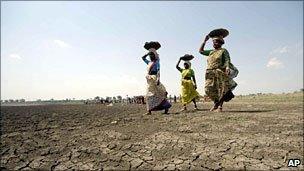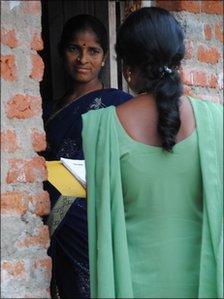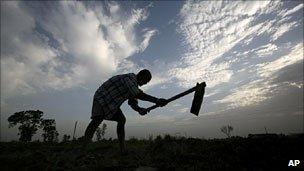Crisis hits India's small loans industry
- Published

Women comprise the bulk of micro-loan borrowers in India
About a year ago, says Vijay Mahajan, he predicted that India's roaring private micro-finance industry would hit the buffers.
As the head of a network of private micro-finance companies, Mr Mahajan has seen the industry pick up at a frenzied pace, giving away $7bn in loans to 30 million households.
The southern state of Andhra Pradesh accounted for a third of these households and nearly half of the loans.
Nothing wrong in that: small loans to the poor who do not qualify for traditional banking credit help lift them out of poverty and spur entrepreneurship.
But Mr Mahajan says he was worried by the reckless lending and feckless borrowing by micro-credit companies and villagers respectively.
This has now led to borrowers defaulting on payments and taking their lives and banks ceasing to lend to the cash-strapped micro-loan companies.
At the root of it, many say, is the increasing greed of the private micro-finance industry in India.
Profits
India's private micro-finance industry - some 50 of the country's 1,000-odd micro-finance institutions are privately owned - appears to be an oligopoly with a handful of companies dominating the market.
In Andhra Pradesh, for example, just four companies account for 80% of the loans. They lend up to $450 to a borrower with few questions asked about what she or he proposes to do with the loan and without sufficiently examining their capacity to repay.
Analysts say these companies are making huge profits - way above those of most banks, public and private.
One of them, SKS Microfinance - India's leading private micro-credit company backed by George Soros, among others - raised more than $350m on the stock market this August. The public share offering was oversubscribed 13 times.
And between 2007 and 2008 alone, private equity players pumped $100m into India's private micro-credit companies.
Like other high-profit industries, micro-credit had to aim for high growth and lent recklessly to the poor, say some analysts.
"Some of these companies are atrociously profitable. They lend more and more money to the same people, who then renege on repayments," says Mr Mahajan.
SKS Microfinance refused to be interviewed for this article.
Also, the uses of small loans have changed over the years, with mixed results.
In the beginning, the loans were given out to help small traders sell vegetables or buy livestock, or for basic farming needs.
In recent years those farming commercial crops (cotton, groundnut, vegetables) or larger livestock (high-yielding buffaloes and cows) received micro-credit.
Industry experts say this is all very well, but requires the borrower to be more astute about handling the "assets" he buys with the loans.
For example, they say, if he purchases larger, high-yielding livestock, the animals need sophisticated veterinary care and insurance and the borrower needs access to buoyant markets.
'Income shocks'
Also, small farmers often lack the education needed to handle "income shocks" arising from one bad crop or a glut in the market, leading to a lowering of prices.
But what has made the situation worse, say analysts, is that micro-loans have been given away freely to villagers to build homes, repay old debts, buy consumer durables like TV sets and pay for family marriages.

Field workers usually travel to rural villages to visit borrowers once a week
"Unless micro-finance companies change their lending model, they will not be able to sustain their business for long," says C Rangarajan, who heads a panel advising the Indian prime minister on economic issues.
"They should lend more for productive purposes and not just for consumption-related expenses. The bulk of the current micro-finance lending is towards consumption."
Critics say avarice and rash business practices have led to India's micro-credit meltdown.
How else, wonder experts, could this happen in Andhra Pradesh where the many of the poor appear to have access to micro-loans?
According to government estimates, small loans worth $6.7bn have been given out to more than 10 million households in the state, the bulk of the money coming from banks and self-help groups.
With 250 million acres of farmland, the state also boasts the highest direct bank crop loans to farmers.
"Over the past decade, there has been immense financial inclusion of the poor and rural credit has gone up," says Reddy Subramanyam, the state' most senior rural development official.
Driving the micro-loan revolution in Andhra Pradesh are the rural self-help groups - they cover some 12 million women with bank loans exceeding $2.5bn.
"Banks are more cautious in lending to the poor. They check whether the loans are going to be used in buying productive assets. Private micro-loan companies have exploited the existing self-help group network and snared their members with easier and faster loans," says Mr Subramanyam.
And with people defaulting, the "very social fabric " put together by the self-help groups where co-members stood as guarantors for each other's loans has been disrupted with members blaming each other for private loan defaults, he says.
Repayment on micro-loans has dropped drastically in the state with politicians asking the borrowers to stop repaying.
Now the panicky state government has pushed through a tough new law that seeks to regulate the industry, much to the latter's consternation.
'Business in peril'
Among other things, the new law prohibits the companies from accepting weekly repayments and demands clearance from local authorities to extend a second loan to a borrower.
"This law will make it impossible for micro-lenders to work in the state and effectively put us out of business there," says Mr Mahajan.

Micro-loans have improved the lives of many farmers
Instead, he recommends that loans of 20% of the worst-affected borrowers be restructured and the payment periods stretched.
Others like Mr Subramanyam feel that banks should increase loans to farmers and cut down on waiting periods so that people do not have to turn to private micro-finance companies.
"Everybody is at fault here," says economic analyst Swaminathan S Anklesaria Aiyar.
"The banks are at fault for failing to provide inclusive finance. State government has failed to create dynamic economies that reduce poverty fast and make people credit-worthy. Self-help groups started well, yet failed to meet credit needs and are suffering loan defaults. Micro-finance companies provided enough finance, but it became too much! They engaged in gross over lending in a sad rush for profits."
Vijay Mahajan fears that if repayments dry up in Andhra Pradesh, the contagion will spread to other states - and the entire micro-loan industry will be in peril.
"The biggest tragedy will be that the 30 million poor households, who got access to bank credit for the first time through micro-finance companies, will have to go back to moneylenders," he says.
Those in government would say the micro-finance meltdown serves as a lesson for an industry distorted by "perverse" profit making and villagers who have borrowed imprudently.
The truth possibly lies somewhere in between.
- Published16 December 2010